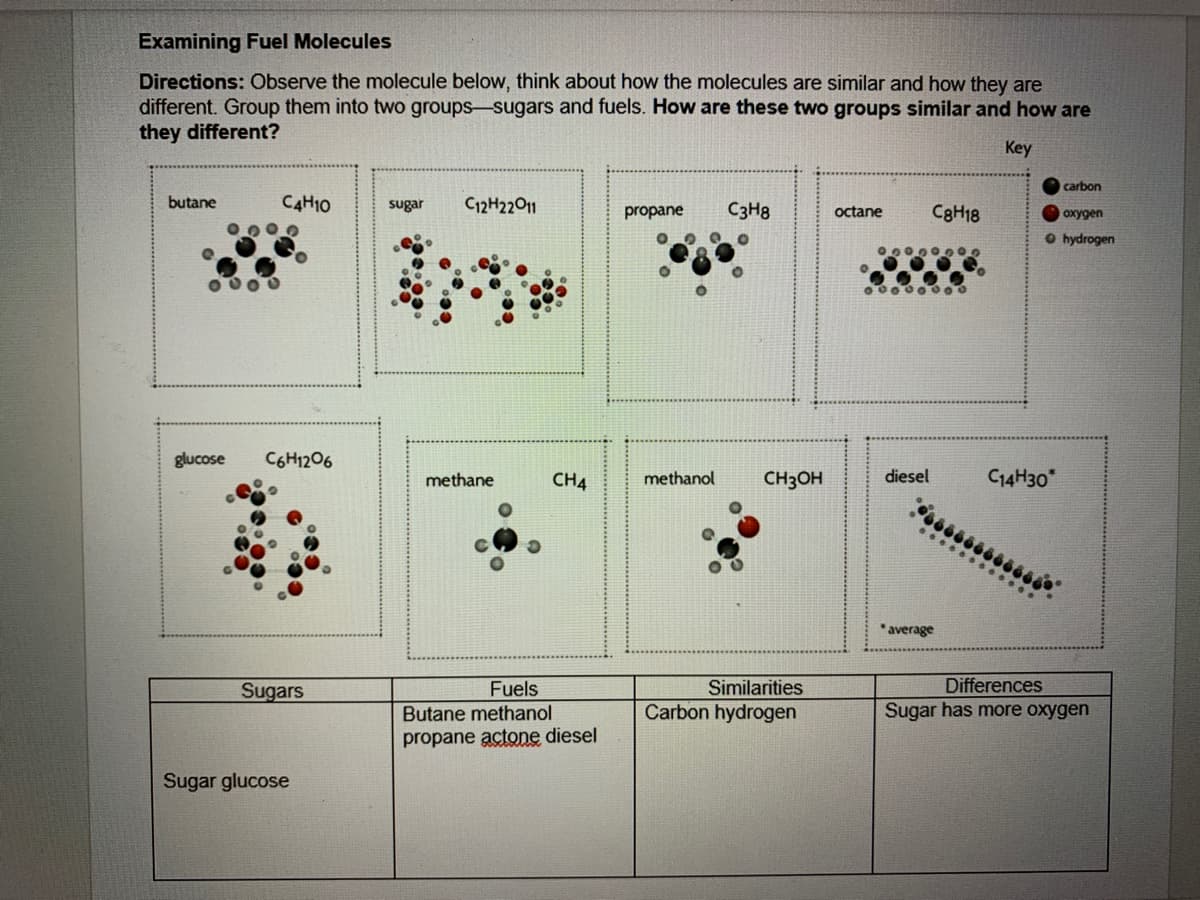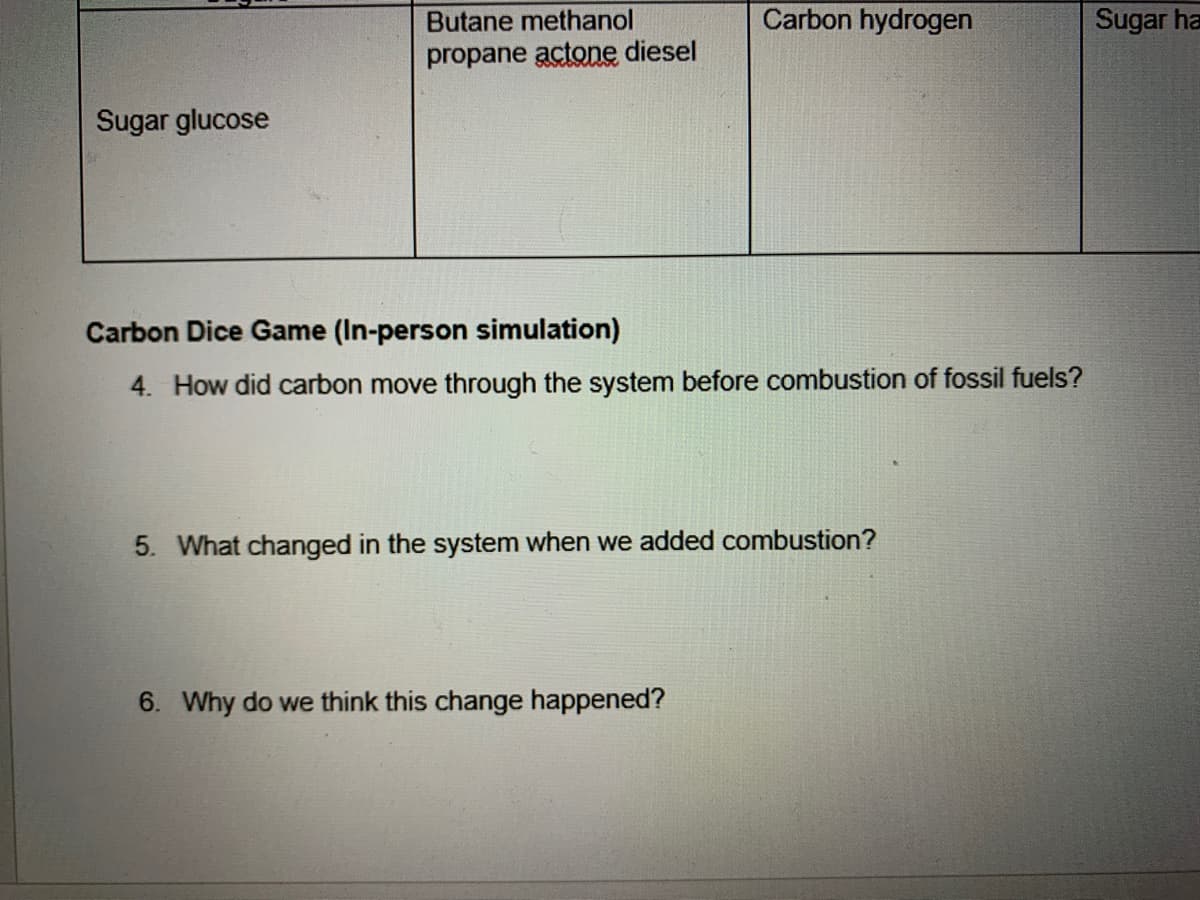Chemistry & Chemical Reactivity
10th Edition
ISBN:9781337399074
Author:John C. Kotz, Paul M. Treichel, John Townsend, David Treichel
Publisher:John C. Kotz, Paul M. Treichel, John Townsend, David Treichel
Chapter5: Principles Of Chemical Reactivity: Energy And Chemical Reactions
Section: Chapter Questions
Problem 115SCQ: Methane, CH4, can be converted to methanol, which, like ethanol, can be used as a fuel. The energy...
Related questions
Question
Please help on questions 4, 5 and 6

Transcribed Image Text:Examining Fuel Molecules
Directions: Observe the molecule below, think about how the molecules are similar and how they are
different. Group them into two groups-sugars and fuels. How are these two groups similar and how are
they different?
Key
carbon
butane
CAH10
sugar
C12H22011
C3H8
CaH18
propane
octane
охудеn
O hydrogen
glucose
C6H1206
methane
CH4
methanol
CH3OH
diesel
C14H30*
average
Differences
Similarities
Carbon hydrogen
Sugars
Fuels
Butane methanol
Sugar has more oxygen
propane actone diesel
Sugar glucose

Transcribed Image Text:Butane methanol
Carbon hydrogen
Sugar ha
propane actone diesel
Sugar glucose
Carbon Dice Game (In-person simulation)
4. How did carbon move through the system before combustion of fossil fuels?
5. What changed in the system when we added combustion?
6. Why do we think this change happened?
Expert Solution
This question has been solved!
Explore an expertly crafted, step-by-step solution for a thorough understanding of key concepts.
Step by step
Solved in 2 steps

Knowledge Booster
Learn more about
Need a deep-dive on the concept behind this application? Look no further. Learn more about this topic, chemistry and related others by exploring similar questions and additional content below.Recommended textbooks for you

Chemistry & Chemical Reactivity
Chemistry
ISBN:
9781337399074
Author:
John C. Kotz, Paul M. Treichel, John Townsend, David Treichel
Publisher:
Cengage Learning

Chemistry & Chemical Reactivity
Chemistry
ISBN:
9781133949640
Author:
John C. Kotz, Paul M. Treichel, John Townsend, David Treichel
Publisher:
Cengage Learning

Chemistry: The Molecular Science
Chemistry
ISBN:
9781285199047
Author:
John W. Moore, Conrad L. Stanitski
Publisher:
Cengage Learning

Chemistry & Chemical Reactivity
Chemistry
ISBN:
9781337399074
Author:
John C. Kotz, Paul M. Treichel, John Townsend, David Treichel
Publisher:
Cengage Learning

Chemistry & Chemical Reactivity
Chemistry
ISBN:
9781133949640
Author:
John C. Kotz, Paul M. Treichel, John Townsend, David Treichel
Publisher:
Cengage Learning

Chemistry: The Molecular Science
Chemistry
ISBN:
9781285199047
Author:
John W. Moore, Conrad L. Stanitski
Publisher:
Cengage Learning

Chemistry for Engineering Students
Chemistry
ISBN:
9781285199023
Author:
Lawrence S. Brown, Tom Holme
Publisher:
Cengage Learning

World of Chemistry
Chemistry
ISBN:
9780618562763
Author:
Steven S. Zumdahl
Publisher:
Houghton Mifflin College Div
